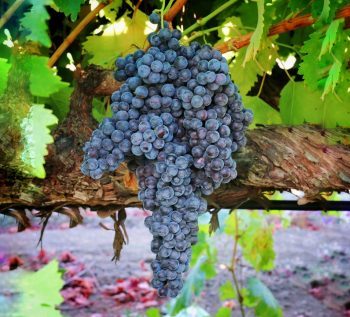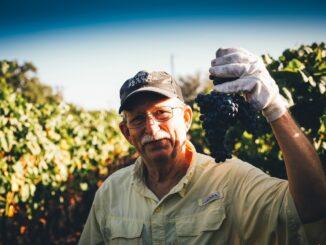
Those of you who read my recent blog (click here) know that in the dark of winter and the festivities of the past holiday season, I’ve gone down the proverbial “rabbit hole” of Texas’s early Spanish Mission vineyard legacy and its grape – Mission (also know as País, Criolla and Listan Prieto). For me, that blog started when I spotted a bottle of Chilean wine – Bouchon País Viejo 2019 – at a local Houston wine shop. It was made with País grapes from 100-year-old vines, dry-farmed, native fermented, and unfiltered. It was a bit old-world “Pinotesque” and good, too.
I was no sooner finished posting this blog, when I was contacted by Dr. Bob Young, owner of Bending Branch Winery. He said that he read with interest my blog piece on the Mission grape and its historic place in Texas winemaking history. Then, he proceeded to inform me that his Ursa Vineyards in the Sierra Foothills was doing something with Mission grapes grown in California. Ursa sells its wines at Branch on High in Comfort and online.
Knowing my interest in Mission grapes Young added, “Just this year we released our first Angelica [Brandy fortified Mission grape wine] from one of the few vineyards that is still growing the mission grape in California. Angelica was consumed in great quantities by the gold miners back in California gold rush days.” I also assume that this was the case on the Mexican/Texas frontier in old El Paso, Texas, too. Click here for link to Ursa Angelica.

I mentioned that while doing background research for my WineSlinger Chronicles book a decade ago I found and tasted a Mission wine from Story Vineyards that has a 0.75 acre heritage Mission vineyard planted in 1894 (click here). I found no evidence of Mission grapes being growing in Texas., but there were anecdotes of a Texas vineyard with Mission grapes that was let go fallow sometime in the 1900s. I’m still lamenting the lack of a heritage Mission vineyard in Texas and would love for a grower, or two or more, to decide to establish heritage planting(s) in Texas with Mission grapes.
I was surprised about a week later when a bottle of wine from Dr. Young showed up in Houston. It was a bottle of a Chilean wine – Pipeño País Coronel de Maule 2019 – 100% Pais from organic, dry-farmed, bush trained vines spontaneously fermented using indigenous yeasts. These grapes reportedly derive from 200 to 300 year old vines. The wine was made saigneé for concentration, then in part aged in stainless steel, large wooden tanks and some in clay vessels.

This wine came with a message from Young, “With your interest in the Texas Mission (País) grape, I thought you would find this wine of interest. The Pipeño is a wine I obtained for our staff’s varietal education. I just thought it would be good for our team to taste the first European grape to be grown and fermented into wine in the US and in Texas.”
Tasting the Pipeño País after the Bouchon, I feel that the Pipeño has a more “original” taste to what the wines of old may have been like, but without being oxidized as many likely were. Both wines were red-berry dominant, but the Pipeño expressed more earthiness and dry-minerally character likely originating from its time in clay. Clay pots (along with hides) were the prevalent wine storage devices in Texas during the early Spanish missionary period.

Alas, with respect to establishing a heritage Mission plantings in Texas, I have not found any leads that might locate any residual plant material left in Texas. I recently spoke with notable Texas “oldtimers” Charles McKinney and Tommy Qualia, and longtime wine consultant Dr. Enrico Ferro, who helped the start-up of the modern Texas wine industry, and still I came up empty-handed. Mission vine stock may be available from one of the existing Mission vineyards in California, Mexico, or much farther away Chile. Vine stock does appear to be available through Foundation Plant Services in California (click here). Listings include 9 Mission source materials:
| Variety Name | Mission |
| TTB Approved Name(s) | Mission |
| Common Synonyms | Criolla Chica, Listán Prieto |
| All Synonyms | California, Creole Petite, Criolla Chica, El Paso, Hariri, Listán Prieto, Misión, Mission’s Grape, Moscatel negro, Negra Corriente, País, Rosa del Perú, Uva del País, Uva negra vino, Uva País, Viña blanca, Viña negra |
| Countries of Origin | Spain |
| Species | Vitis vinifer |
| Mission 02 | |
| Registration Status | Registered |
| Source | California vineyard |
| Treatments | None |
| Comments | This selection came to Davis from a California vineyard in Woodbridge, California, around 1959. |
| Mission 06 | |
| Registration Status | Registered |
| Source | Vineyard in Calaveras County |
| Treatments | None |
| Comments | This selection came to Davis from a vineyard in Calaveras County, California, around 1964. |
| Mission 07 | |
| Registration Status | Registered |
| Source | Port Orford, California |
| Treatments | None |
| Comments | This selection came to Davis from a vineyard in Port Orford, California, around 1963. |
| Mission 08 | |
| Registration Status | Registered |
| Source | Port Orford, California |
| Treatments | None |
| Comments | This selection came to Davis from a vineyard in Port Orford, California, around 1964. |
| Mission 09 | |
| Registration Status | Registered |
| Source | Mission FPS 02 |
| Treatments | Heat treatment 66 days |
| Mission 11 | |
| Registration Status | Registered |
| Source | Jackson, California |
| Treatments | None |
| Comments | This selection came to FPS from the vineyard at the former University of California Experiment Station in Jackson, California in 1963. |
| Mission 12 | |
| Registration Status | Registered |
| Source | California vineyard around 1965 |
| Treatments | None |
| Mission 13 | |
| Registration Status | Registered |
| Source | Jackson, California |
| Treatments | None |
| Comments | This selection came to FPS from the vineyard at the former University of California Experiment Station in Jackson, California, in 1966. |
| Mission 17 | |
| Registration Status | Registered |
| Source | Very old vineyard in Santa Barbara County |
| Treatments | None |
| Comments | This historically significant selection was donated to the public grapevine collection at Foundation Plant Services, UC Davis, in 2013 by Deborah Hall, winemaker and owner of Gypsy Canyon Winery in the Santa Rita Hills, California. In 1999, Ms. Hall discovered this selection growing in an old vineyard in Santa Barbara County. The Mission vines were reportedly planted around 1887. Since 1999, Gypsy Canyon has donated cuttings from the old Mission vines to various California missions to restore the mission vineyards. The collection at Mission San Luis Rey is the largest of those restored collections. The material successfully completed testing at FPS and qualified for the California Grapevine Registration & Certification Program in 2015. See also, Mission FPS 17.1. |
If there are any Texas grape growers out there that are interested in bringing back a planting of Mission grapes to Texas for their historic value or for the recent resurgence of interest in the its wines by young, edgy sommeliers, please by all means give it a go AND please keep me posted so that I can chronicle the process.



Russ: I always enjoy reading about your adventures into our great Texas winemaking history, especially now that I have retired from hands-on winemaking. Your recent posting about the University of Texas 1995 Experimental Pecos County, Cabernet Sauvignon, piqued my memory. In checking my home wine library I confirmed what my aging memory had conceived and that was that i have a bottle of University of Texas 1995 Experimental Pecos County, Merlot. If my memory serves me correctly, I am sure it was a gift to me from Jim Evans many years ago. Maybe sometime later this year, I may garner the strength to delicately remove its corked seal, decant it into a special decanter, allow it to breath and open up a little and then savor the moments when Jim and his crew actually crushed, fermented, oak aged and sealed this rare old bottle of Texas wine.
Cheers & Ciao and keep on writing!
I might suggest that you do what I do in sampling this wine. That is to initially use a Coravin to extract a sample for tasting. If it proves worthy, then you will still have a sealed bottle if you want to share it with friends and associates.